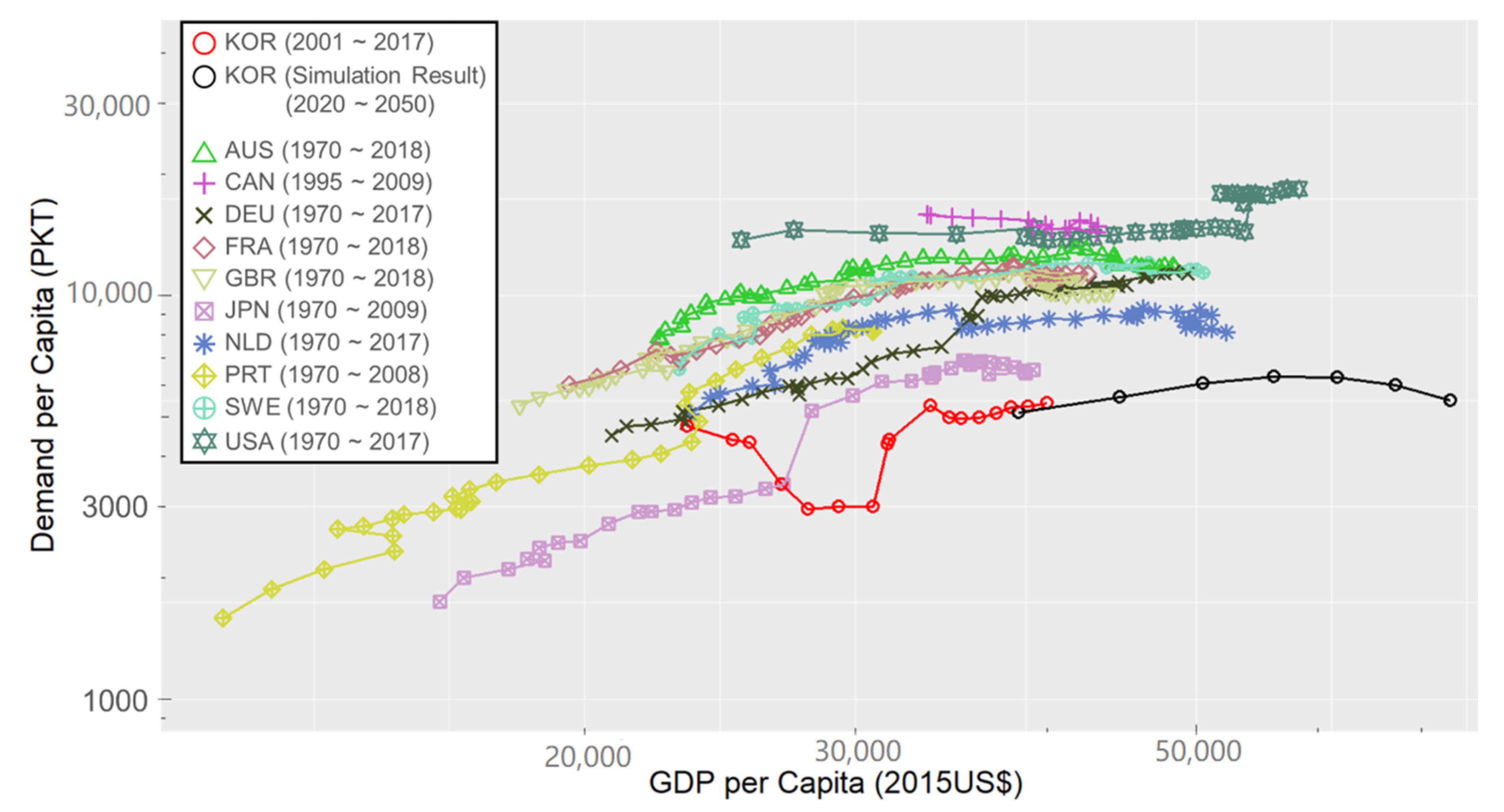An Assessment of Corporate Average Fuel Economy Standards for Passenger Cars in South Korea
Abstract
1. Introduction
2. Current Status of Passenger Cars in South Korea
3. CAFE Standards in South Korea and the Objective of this Study
- : average fuel efficiency performance,
- : average fuel efficiency standard,
- : total sales of cars,
- : car model ,
- : sales of car model ,
- : fuel efficiency performance of car model i,
- : fuel efficiency standard of car model .
- , , and : given parameters,
- : the curb weight of car model .
4. Methodology and Data
4.1. Global Change Assessment Model
- : Passenger transportation demand (passenger kilometers travelled or PKT),
- : Per capita income ($),
- : Price of transportation service ($/PKT),
- : Population,
- : Income elasticity,
- : Price elasticity,
- : Year in five-year time steps (for example, 2010 for calibration, 2015, 2020).
- : Sector (for example, passenger road sector, passenger rail sector),
- : Mode (for example, small car, medium car),
- : Technology (for example, ICEV, BEV),
- : Hourly wage ($/h),
- : Speed of mode (km/h),
- : A parameter for the calculation of value of time,
- : Fuel price ($/joule),
- : Energy intensity (joule/VKT),
- : Non-fuel price ($/VKT),
- : Load factor (PKT/VKT),
- : Market share.
4.2. Vehicle Cost Assumptions
4.3. Scenario Description
5. Results
6. Conclusions
Supplementary Materials
Author Contributions
Funding
Acknowledgments
Conflicts of Interest
References
- International Energy Agency (IEA). World Energy Balances. 2019. Available online: https://www.iea.org/subscribe-to-data-services/world-energy-balances-and-statistics (accessed on 23 June 2020).
- International Energy Agency (IEA). CO2 Emissions from Fuel Combustion. Available online: https://www.iea.org/subscribe-to-data-services/co2-emissions-statistics (accessed on 23 June 2020).
- Korea Energy Economics Institute (KEEI). 2018 Yearbook of Energy Statistics; Korea Energy Economics Institute: Ulsan, Korea, 2018; Available online: http://www.keei.re.kr/keei/download/YES2018.pdf (accessed on 18 February 2020).
- Curran, S.J.; Wagner, R.M.; Graves, R.L.; Keller, M.; Green, J.B., Jr. Well-to-wheel analysis of direct and indirect use of natural gas in passenger vehicles. Energy 2014, 75, 194–203. [Google Scholar] [CrossRef]
- Durrmeyer, I.; Samano, M. To rebate or not to rebate: Fuel economy standards versus feebates. Econ. J. 2018, 128, 3076–3116. [Google Scholar] [CrossRef]
- National Highway Traffic Safety Administration (NHTSA). Corporate Average Fuel Economy. Available online: https://www.nhtsa.gov/laws-regulations/corporate-average-fuel-economy (accessed on 19 July 2019).
- Khan, M.I.; Shahrestani, M.; Hayat, T.; Shakoor, A.; Vahdati, M. Life cycle (well-to-wheel) energy and environmental assessment of natural gas as transportation fuel in Pakistan. Appl. Energy 2019, 242, 1738–1752. [Google Scholar] [CrossRef]
- Song, Q.; Wu, Y.; Li, J.; Wang, Z.; Yu, D.; Duan, H. Well-to-wheel GHG emissions and mitigation potential from light-duty vehicles in Macau. Int. J. Life Cycle Assess. 2018, 23, 1916–1927. [Google Scholar] [CrossRef]
- Jang, J.J.; Song, H.H. Well-to-wheel analysis on greenhouse gas emission and energy use with petroleum-based fuels in Korea: Gasoline and diesel. Int. J. Life Cycle Assess. 2015, 20, 1102–1116. [Google Scholar] [CrossRef]
- Yanni, T.; Paul, J. Impact and sensitivity of vehicle design parameters on fuel economy estimates. No. 2010-01-0734. SAE Tech. Pap. 2010. [Google Scholar] [CrossRef]
- Ministry of Land, Infrastructure and Transport (MOLIT). Total Registered Motor Vehicles. Available online: https://stat.molit.go.kr/portal/main/portalMain.do (accessed on 24 June 2020).
- Korea Transport Institute (KOTI). Korea Transportation Statistics (Various Years), Korea Transport Institute. Available online: https://www.ktdb.go.kr/www/index.do (accessed on 23 June 2020).
- Korea Energy Economics Institute (KEEI). Energy Consumption Survey (Various Years), Korea Energy Economics Institute. Available online: http://www.kesis.net/sub/sub_0002.jsp?M_MENU_ID=M_M_002&S_MENU_ID=S_M_010 (accessed on 24 June 2020).
- International Energy Agency (IEA). Global EV Outlook 2019; International Energy Agency: Paris, France, 2019; Available online: https://webstore.iea.org/global-ev-outlook-2019 (accessed on 24 June 2020).
- International Energy Agency (IEA). Energy Use Rationalization Act. Available online: https://www.iea.org/policies/392-energy-use-rationalization-act (accessed on 28 August 2020).
- Ministry of Trade, Industry and Energy. Energy Efficiency Innovation Strategy, South Korea. 2019. Available online: http://www.motie.go.kr/motie/ne/presse/press2/bbs/bbsView.do?bbs_cd_n=81&bbs_seq_n=161993 (accessed on 28 June 2020).
- Korea Energy Agency (KEA). Vehicle Fuel Economy and CO2 Emissions: Data and Analyses (Various Years), Korea Energy Agency. Available online: http://bpms.kemco.or.kr/transport_2012/pds/month_pds.aspx (accessed on 24 June 2020).
- Van Vuuren, D.P.; Edmonds, J.; Kainuma, M.; Riahi, K.; Thomson, A.; Hibbard, K.; Hurtt, G.; Kram, T.; Krey, V.; Lamarque, J.-F.; et al. The representative concentration pathways: An overview. Clim. Chang. 2011, 109, 5. [Google Scholar] [CrossRef]
- Kim, S.H.; Edmonds, J.; Lurz, J.; Smith, S.J.; Wise, M. The ObjECTS framework for integrated assessment: Hybrid modeling of transportation. Energy J. 2006. [Google Scholar] [CrossRef]
- Mishra, G.S.; Kyle, P.; Teter, J.; Morrison, G.M.; Kim, S.; Yeh, S. Transportation module of Global Change Assessment Model (GCAM): Model Documentation; Institute of Transportation Studies, University of California: Davis, CA, USA, 2013; Available online: https://trid.trb.org/view.aspx?id=1262949 (accessed on 28 August 2020).
- Kyle, P.; Kim, S.H. Long-term implications of alternative light-duty vehicle technologies for global greenhouse gas emissions and primary energy demands. Energy Policy 2011, 39, 3012–3024. [Google Scholar] [CrossRef]
- Yin, X.; Chen, W.; Eom, J.; Clarke, L.E.; Kim, S.H.; Patel, P.L.; Yu, S.; Kyle, G.P. China’s transportation energy consumption and CO2 emissions from a global perspective. Energy Policy 2015, 82, 233–248. [Google Scholar] [CrossRef]
- Jeon, S.; Kim, S. Modeling Domestic Transportation Sector Using Global Change Assessment Model. J. Korean Soc. Transp. 2017, 35, 91–104. [Google Scholar] [CrossRef][Green Version]
- Jeon, S.; Roh, M.; Oh, J.; Kim, S. Development of an Integrated Assessment Model at Provincial Level: GCAM-Korea. Energies 2020, 13, 2565. [Google Scholar] [CrossRef]
- Korea Transportation Safety Authority (TS). Automobile Mileage Analysis (Various Years), Korea Transportation Safety Authority. Available online: https://www.kotems.or.kr/app/kotems/forward?pageUrl=/kotems/ptl/bbs/KotemsPtlBbsStatsLs&topmenu1=06&topmenu2=03&topmenu3=03 (accessed on 25 June 2020).
- Joint Global Change Research Institute (JGCRI). GCAM v5.1 Documentation: Global Change Assessment Model (GCAM). Available online: http://jgcri.github.io/gcam-doc (accessed on 14 April 2020).
- Lutsey, N.; Nicholas, M. Update on Electric Vehicle Costs in the United States through 2030. Int. Counc. Clean Transp. 2019, 1–12. Available online: https://theicct.org/sites/default/files/publications/EV_cost_2020_2030_20190401.pdf (accessed on 19 July 2020).
- Soulopoulos, N. When will electric vehicles be cheaper than conventional vehicles. Bloom. New Energy Financ. 2017, 12. Available online: https://www.blogmotori.com/wp-content/uploads/2017/07/EV-Price-Parity-Report_BlogMotori_COM_MobilitaSostenibile_IT.pdf (accessed on 19 July 2020).
- Ruffini, E.; Wei, M. Future costs of fuel cell electric vehicles in California using a learning rate approach. Energy 2018, 150, 329–341. [Google Scholar] [CrossRef]
- Morrison, G.; Stevens, J.; Joseck, F. Relative economic competitiveness of light-duty battery electric and fuel cell electric vehicles. Transp. Res. Part C Emerg. Technol. 2018, 87, 183–196. [Google Scholar] [CrossRef]
- Dunkerley, F.; Rohr, C.; Daly, A. Road Traffic Demand Elasticities: A Rapid Evidence Assessment. 2014. Available online: https://www.rand.org/pubs/research_reports/RR888.html (accessed on 28 June 2020).
- Organization for Economic Co-operation and Development (OECD). Road Passenger Transport by Passenger Cars. Available online: https://data.oecd.org/transport/passenger-transport.htm (accessed on 27 June 2020).
- Organization for Economic Co-Operation and Development (OECD). Level of GDP per Capita and Productivity. Available online: https://stats.oecd.org/Index.aspx?DataSetCode=PDB_LV (accessed on 27 June 2020).
- Krause, J.; Thiel, C.; Tsokolis, D.; Samaras, Z.; Rota, C.; Ward, A.; Prenninger, P.; Coosemans, T.; Neugebauer, S.; Verhoeve, W. EU road vehicle energy consumption and CO2 emissions by 2050–Expert-based scenarios. Energy Policy 2020, 138, 111224. [Google Scholar] [CrossRef]
- Bloomberg New Energy Finance (BNEF). Electric Vehicle Outlook 2020. Bloomberg Finance Limited Partnership. 2020. Available online: https://about.bnef.com/electric-vehicle-outlook/ (accessed on 20 July 2020).
- Parker, S.; Bhatti, M.I. Dynamics and drivers of per capita CO2 emissions in Asia. Energy Econ. 2020, 104798. [Google Scholar] [CrossRef]
- World Bank. CO2 Emissions (Metric Tons per Capita). Available online: https://data.worldbank.org/indicator/EN.ATM.CO2E.PC (accessed on 25 August 2020).
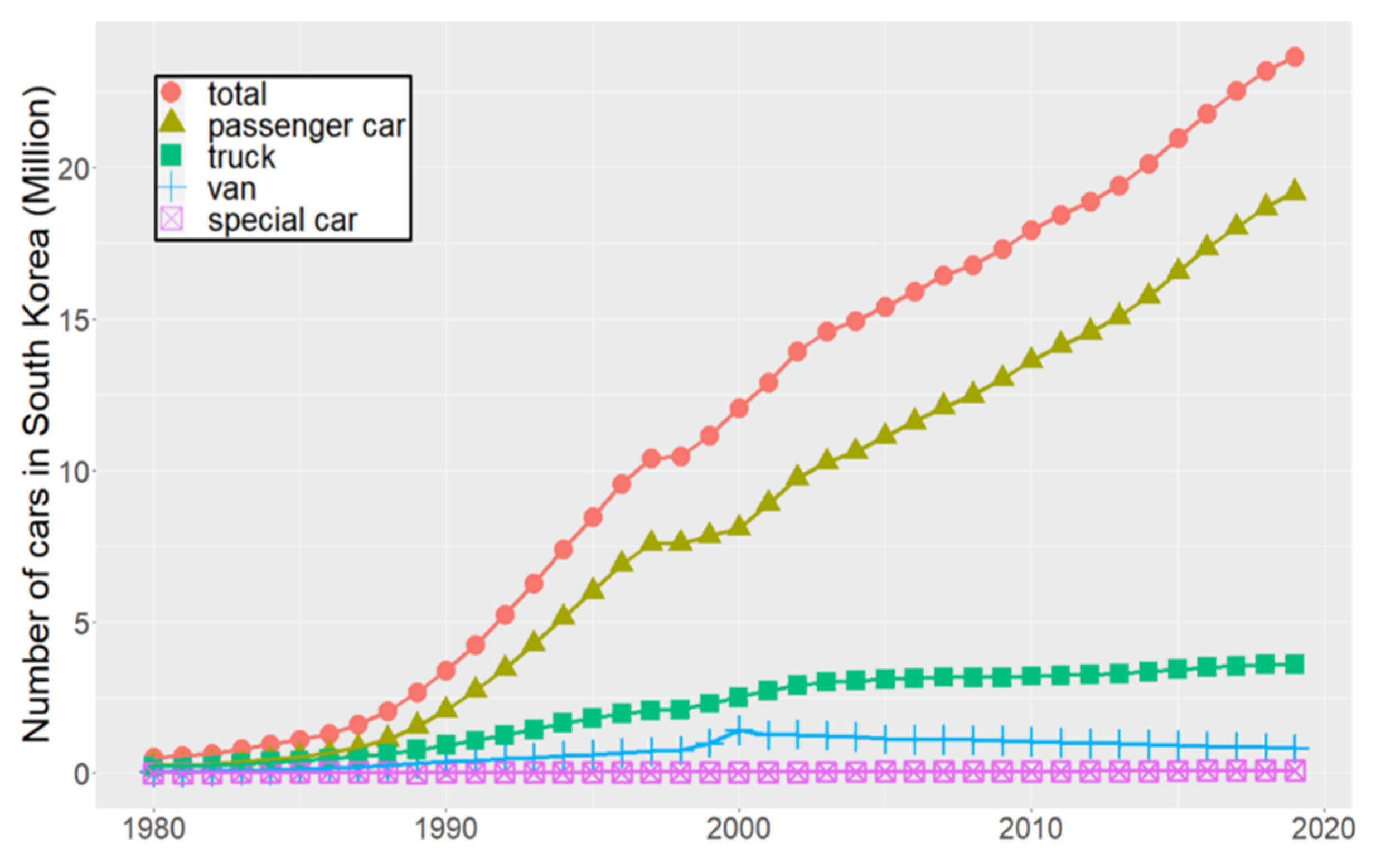
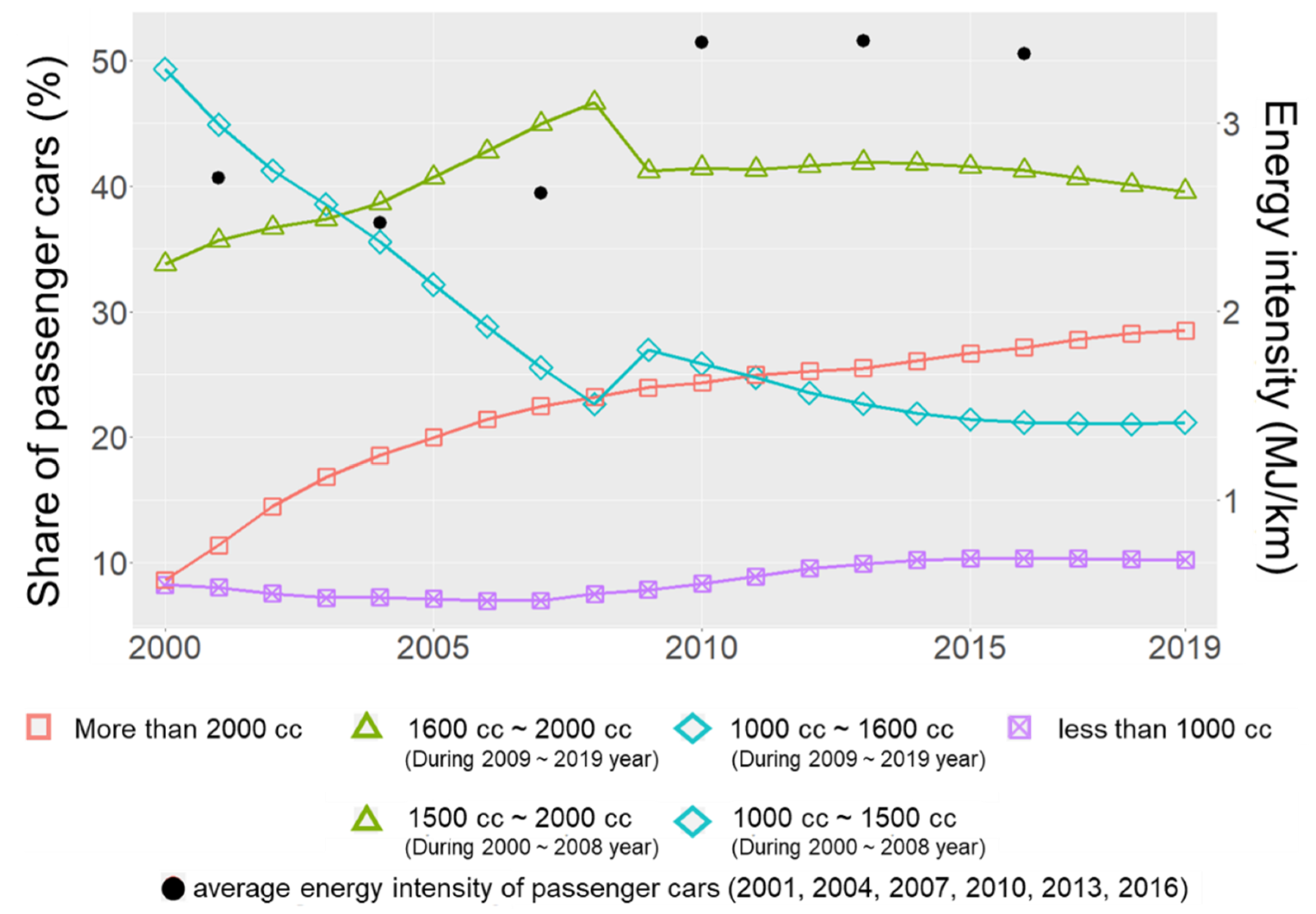

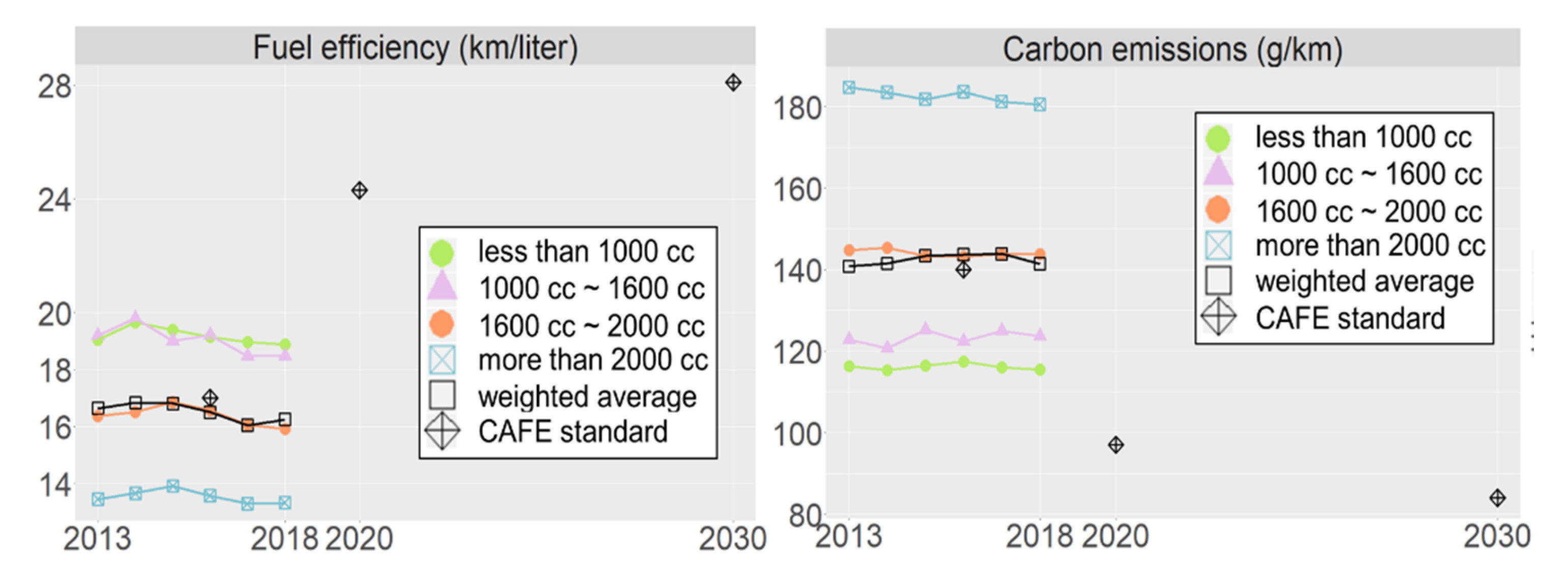

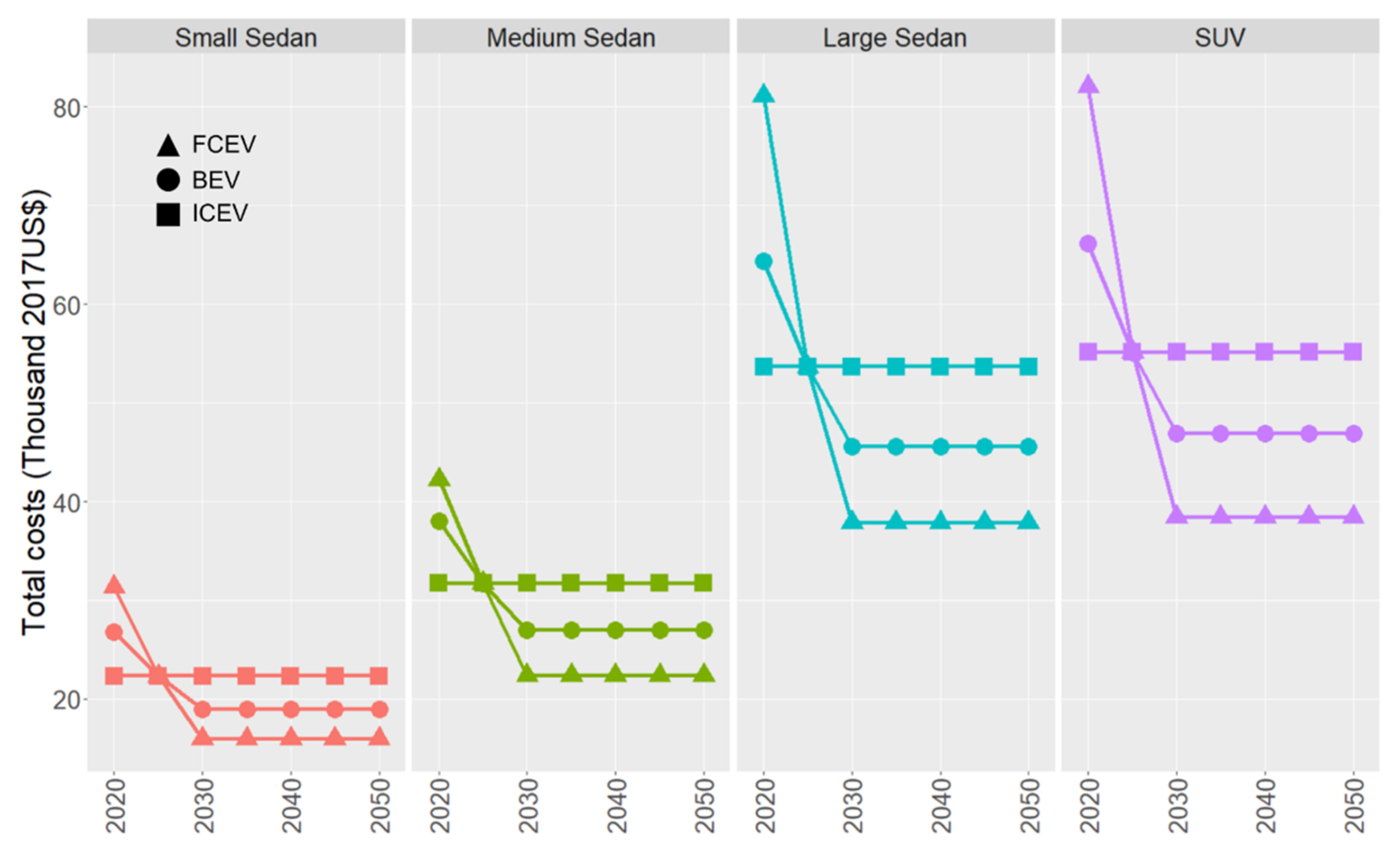

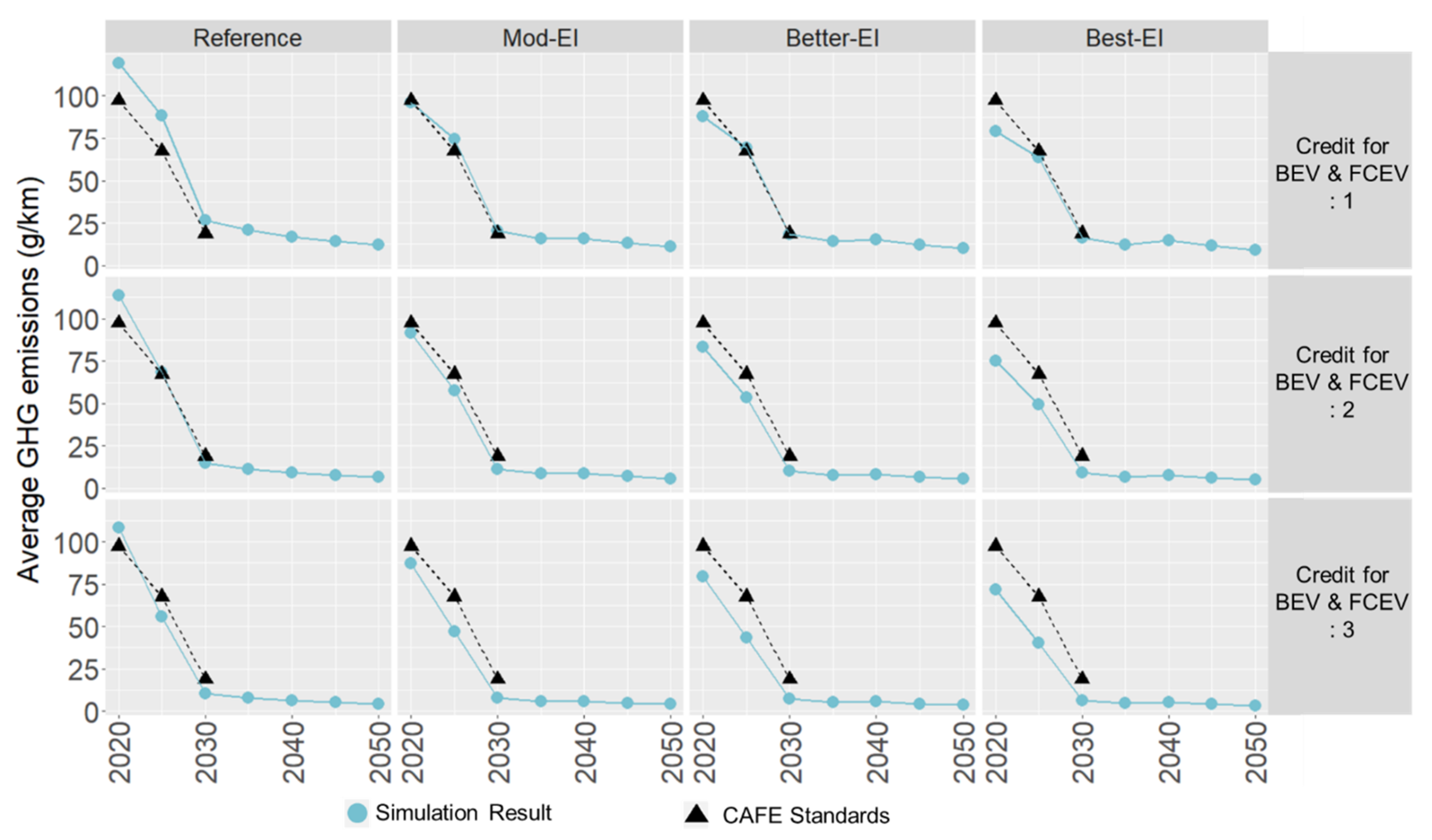
| Scenario | Description | Tech | Relative Energy Intensity of Passenger Cars | |||
|---|---|---|---|---|---|---|
| 2020 | 2030 | 2040 | 2050 | |||
| Reference | No improvement | ICEV | 1 | 1 | 1 | 1 |
| BEV | 1 | 1 | 1 | 1 | ||
| FCEV | 1 | 1 | 1 | 1 | ||
| Mod-EI | Moderate improvement in energy intensity | ICEV | 1 | 0.889 | 0.800 | 0.727 |
| BEV | 1 | 0.881 | 0.838 | 0.821 | ||
| FCEV | 1 | 0.842 | 0.825 | 0.816 | ||
| Better-EI | High improvement in energy intensity | ICEV | 1 | 0.849 | 0.720 | 0.627 |
| BEV | 1 | 0.841 | 0.758 | 0.721 | ||
| FCEV | 1 | 0.802 | 0.745 | 0.716 | ||
| Best-EI | Very high improvement in energy intensity | ICEV | 1 | 0.809 | 0.640 | 0.527 |
| BEV | 1 | 0.801 | 0.678 | 0.621 | ||
| FCEV | 1 | 0.762 | 0.665 | 0.616 | ||
© 2020 by the authors. Licensee MDPI, Basel, Switzerland. This article is an open access article distributed under the terms and conditions of the Creative Commons Attribution (CC BY) license (http://creativecommons.org/licenses/by/4.0/).
Share and Cite
Jeon, S.; Roh, M.; Heshmati, A.; Kim, S. An Assessment of Corporate Average Fuel Economy Standards for Passenger Cars in South Korea. Energies 2020, 13, 4533. https://doi.org/10.3390/en13174533
Jeon S, Roh M, Heshmati A, Kim S. An Assessment of Corporate Average Fuel Economy Standards for Passenger Cars in South Korea. Energies. 2020; 13(17):4533. https://doi.org/10.3390/en13174533
Chicago/Turabian StyleJeon, Seungho, Minyoung Roh, Almas Heshmati, and Suduk Kim. 2020. "An Assessment of Corporate Average Fuel Economy Standards for Passenger Cars in South Korea" Energies 13, no. 17: 4533. https://doi.org/10.3390/en13174533
APA StyleJeon, S., Roh, M., Heshmati, A., & Kim, S. (2020). An Assessment of Corporate Average Fuel Economy Standards for Passenger Cars in South Korea. Energies, 13(17), 4533. https://doi.org/10.3390/en13174533





